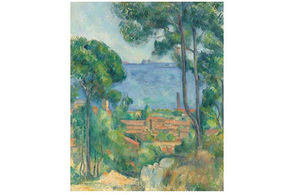Cézanne masterpiece may leave UK
Temporary export bar placed on rare painting by Cézanne

An important Cézanne painting that has been on long-term loan to the Fitzwilliam Museum, Cambridge for almost 30 years is at risk of being exported unless a UK buyer can be found to match the £13,522,500 asking price.
In order to provide a last chance to keep it in the UK, Culture Minister Ed Vaizey has placed a temporary export bar on the painting, Vue sur L’Estaque et le Château d’If (View of L’Estaque and the Château d’If)
Culture Minister Ed Vaizey said:
For almost 30 years this quietly beautiful painting has adorned the walls of the Fitzwilliam Museum where it has been enjoyed by countless visitors. I hope that the temporary export bar I have put in place will result in a UK buyer coming forward and that the painting will soon be back on the walls of one of our great public collections.
This painting is a vibrant treatment of one of Cézanne’s favourite subjects, the Bay of L’Estaque on the Mediterranean at Marseilles, and is the only example of a view of L’Estaque executed in vertical format. Cézanne painted at L’Estaque from the 1870s and the landscapes he executed in the early ’80s from high vantage points overlooking the bay are among his calmest and most magisterial evocations of the Mediterranean. Whilst there are 35 paintings by Cézanne in British museums and galleries, there are no paintings of the Bay of L’Estaque among them, and consequently a vital aspect of Cézanne’s achievement is missing from our great public collections.
The painting was acquired in 1936 by Samuel Courtauld (1876-1947) and descended in his family until its sale in February of this year. During his lifetime, Courtauld assembled the greatest collection of impressionist and post-impressionist art formed in this country and was instrumental in bringing these movements to the wider attention of the British public. Vue sur L’Estaque et le Château d’If was the last of twelve Cézanne canvases Courtauld acquired and has subsequently become well-known to the British public during the twenty nine years (1985 to 2014) it hung on long-term loan at the Fitzwilliam Museum, Cambridge.
Culture Minister Ed Vaizey took the decision to defer granting an export licence for the painting following a recommendation by the Reviewing Committee on the Export of Works of Art and Objects of Cultural Interest (RCEWA), administered by Arts Council England. The RCEWA made their recommendation on the grounds that it is of outstanding aesthetic importance, it has a close association with our history and national life, and it is significant for the study of Cézanne’s painting, in particular his work of the 1880s.
RCEWA Member Aidan Weston-Lewis said:
Cézanne was a painter whose art was forged out of prolonged meditation on familiar motifs. Like Mont Sainte-Victoire, the village of L’Estaque and the Bay of Marseilles beyond was a view he returned to repeatedly during the 1870s and 1880s, and it inspired some of his most ground-breaking pictures of these decades. This is a rare opportunity to fill a significant gap in the UK’s otherwise impressive holdings of Cézanne’s work.
The decision on the export licence application for the painting will be deferred for a period ending on 21 December 2015 inclusive. This period may be extended until 21 June 2016 inclusive if a serious intention to raise funds to purchase the painting is made at the recommended price of £13,522,500 (plus VAT which could be reclaimed by an eligible institution).
For media information contact: Alison Millar Media Relations Officer, Arts Council England Tel: 0207 268 9648 Mobile: 07712 854903 Email: [email protected]
Notes to Editors
-
Organisations or individuals interested in purchasing the painting should contact RCEWA on 0845 300 6200.
-
Detail of the painting are as follows:
Paul Cézanne (1839 – 1906) Vue sur L’Estaque et le Château d’If Oil on canvas, 73 x 59.7cm Unsigned Painted circa 1883 - 1885
-
The Reviewing Committee on the Export of Works of Art and Objects of Cultural Interest is an independent body, serviced by Arts Council England, which advises the Secretary of State for Culture, Media and Sport on whether a cultural object, intended for export, is of national importance under specified criteria.
-
Arts Council England champions, develops and invests in artistic and cultural experiences that enrich people’s lives. We support a range of activities across the arts, museums and libraries – from theatre to digital art, reading to dance, music to literature, and crafts to collections. Great art and culture inspires us, brings us together and teaches us about ourselves and the world around us. In short, it makes life better. Between 2015 and 2018, we plan to invest £1.1 billion of public money from government and an estimated £700 million from the National Lottery to help create these experiences for as many people as possible across the country.www.artscouncil.org.uk